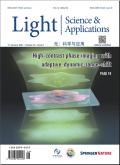Peculiarities of room temperature organic photodetectors.
IF 23.4
Q1 OPTICS
引用次数: 0
Abstract
Organic semiconductors (OSCs) have been considered as projecting family of optoelectronic materials broadly investigated for more than 40 years due to capability to tune properties by adjusting chemical structure and simple processing. The OSCs performance has been substantially increased, due to the fast development in design and synthesis. The spectral response of OSCs was extended from ultraviolet (UV) to near infrared (NIR) wavelength region. There are papers reporting detectivity (D*) higher than the physical limits set by signal fluctuations and background radiation. This paper attempts to explain the organic photodetectors' peculiarities when confronted with typical devices dominating the commercial market. To achieve this goal, the paper first briefly describes OSC deposition techniques, diametrically opposed to those used for standard semiconductors. This was followed by a more detailed discussion of basic physical properties, contributing to the photodetectors' performance including absorption coefficient, conduction mechanism, charge generation and charge transport. These effects are very different from those found in inorganic semiconductors (ISCs). The second part of the paper describes the main modes of OSC based photodetectors [photoconductors, photodiodes and field effect transistor photodetectors (FET)] with emphasis on their special features that distinguish them from standard photodetectors. Final part of the paper shows current state-of-the-art of various types/structures of photodetectors and routes for further improvement. The upper detection limit for OSC photodiodes has been shown to be comparable to that for ISC photodiodes with nearly three orders of magnitude variation. The D* overestimates (especially organic based FET phototransistors) were explained.室温有机光电探测器的特性。
有机半导体(OSCs)由于其能够通过调整化学结构和简单的加工来调整其性能,被认为是40多年来被广泛研究的一个突出的光电材料家族。由于在设计和合成方面的快速发展,OSCs的性能得到了很大的提高。OSCs的光谱响应从紫外(UV)扩展到近红外(NIR)波长区域。有论文报告探测能力(D*)高于由信号波动和背景辐射设定的物理极限。本文试图解释有机光电探测器在面对主导商业市场的典型器件时的特殊性。为了实现这一目标,本文首先简要描述了OSC沉积技术,与用于标准半导体的技术截然相反。随后对光电探测器的吸收系数、传导机制、电荷产生和电荷输运等基本物理性质进行了详细的讨论。这些效应与无机半导体(ISCs)中的效应非常不同。论文的第二部分描述了基于OSC的光电探测器的主要模式[光电导体、光电二极管和场效应晶体管光电探测器(FET)],重点介绍了它们与标准光电探测器的区别。论文的最后一部分展示了目前各种类型/结构的光电探测器的最新技术和进一步改进的路线。OSC光电二极管的检测上限已被证明与ISC光电二极管相当,相差近三个数量级。解释了D*的高估(特别是基于有机FET的光电晶体管)。
本文章由计算机程序翻译,如有差异,请以英文原文为准。
求助全文
约1分钟内获得全文
求助全文
来源期刊

Light-Science & Applications
数理科学, 物理学I, 光学, 凝聚态物性 II :电子结构、电学、磁学和光学性质, 无机非金属材料, 无机非金属类光电信息与功能材料, 工程与材料, 信息科学, 光学和光电子学, 光学和光电子材料, 非线性光学与量子光学
自引率
0.00%
发文量
803
审稿时长
2.1 months
 求助内容:
求助内容: 应助结果提醒方式:
应助结果提醒方式:


